For the most part, it's desirable to have a strong brand with passionate followers. When people want your brand, you can charge more for its products. But it can be difficult to extend a strong brand into new product classes. Its most avid customers could feel that the new product doesn't befit the brand and reject it, with feeling. This happened with Jeep's first car-based crossovers, the 2007 Compass and Patriot. To be fair, Jeep sold over 180,000 of the sibs last year, but would not have without heavy incentives. Neither has ever really been accepted as a Jeep. Undeterred, last spring Jeep introduced an even smaller model, the Renegade. Based on a Fiat platform and manufactured in Italy, could the Renegade possibly seem a more legitimate Jeep than the Compass and Patriot?
I first evaluated a Renegade, in off-road-optimized Trailhawk form, as a foil for the Chevrolet Trax last May. The ute was borrowed from a dealer, so that experience left me wanting more time in the seat. I've since reviewed two other small crossovers, the Honda HR-V and Mazda CX-3, but both compete more directly with the Renegade's sportier, more car-like sibling, the Fiat 500X (also evaluated in the Trax review). Only one other small crossover has anything resembling offroading pretensions, the Subaru Crosstrek, but I have a hard time seeing it as a crossover and at any rate have yet to drive one (possibly soon). Unlike the Honda and Mazda, the Trax at least looks somewhat trucky. So it seems I'll once again be comparing the small Jeep to the small Chevrolet, just with the focus now on the former.
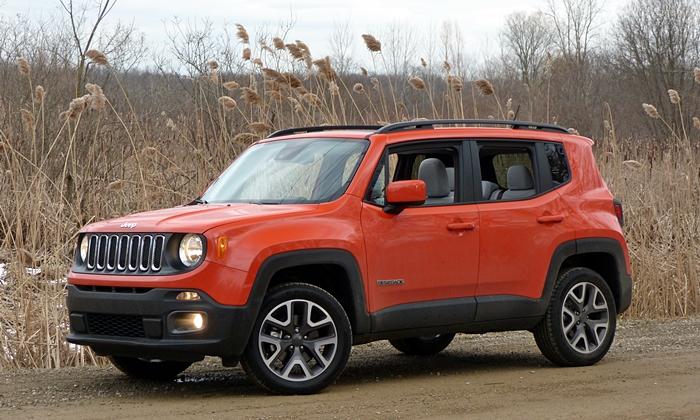
Renegade's chunky upright styling is more appropriate for a Jeep than the Cherokee's sleeker shape more Renegade photos
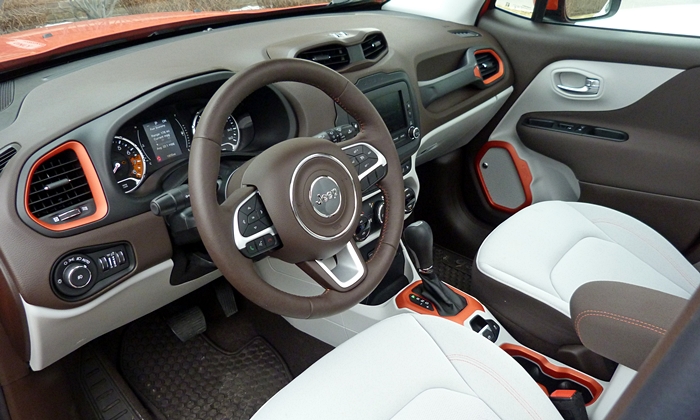
Why light gray instead of sand cloth? Perhaps for maximum contrast with brown and orange. Too much?
| |
Compared to the Trax |
| Off-road capability |
 Better
Worse
Better
Worse
|
Most small crossovers don't even pretend to be capable of venturing off-road. The Jeep not only looks the part, but it has hardware to back up its rugged styling.
Like the Compass and Patriot, the Renegade does not have a two-speed transfer case. Instead, a wide-ratio transmission coupled with a low final drive ratio (16% lower--meaning numerically higher--in the Trailhawk than in other Renegades) delivers a much lower crawl ratio than you can get in other small crossovers. This improves traction and control on difficult terrain. For example, the crawl ratio in the Subaru Crosstrek is 13:1. In the Compass and Patriot with an off-road package it is 19:1. In the regular Renegade it approaches 18:1, while in the Trailhawk it tops 20:1.
Many potential buyers will be happy to hear that, unlike in the Compass and Patriot, a CVT (continuously variable transmission) is not employed to provide a decent crawl ratio. Instead, the Renegade has a conventional automatic, but one with nine ratios. When you have nine ratios to work with, first gear can be a stump-puller.
The Trailhawk also rides 0.8 inches higher than the regular Renegade. Its 8.7-inch ground clearance ties that of the Crosstrek and is well above the Trax's 6.2 inches. The Trailhawk's tweaks also include hill descent control, which automatically manages the throttle and brakes to maintain a safe speed down steep slopes. In all Renegades the optional all-wheel-drive system includes a terrain selector, to customize the power train and stability control programming for snow, sand, or mud. (The Trailhawk adds a "rocks" mode.)
The upshot: befitting a Jeep, the Renegade is the most capable off-roader in the class.
To keep things in perspective, a 20:1 crawl ratio isn't going to excite hardcore off-roaders. Equipped with two-speed transfer cases, the Cherokee Trailhawk has a crawl ratio of 56:1 or 48:1 (depending on engine) and the Wrangler Rubicon has a crawl ratio of 73:1. The Renegade Trailhawk's crawl ratio might be best-in-class by a wide margin, but Jeep enthusiasts won't be trading their Wranglers in for them.
| Exterior styling |
 Better
Worse
Better
Worse
|
I'm not a fan of the tri-lamp face and distended nose of the Jeep Cherokee. The Renegade, with a squarer, more upright profile and large, round headlamps, also is not beautiful in any conventional sense, but it looks much more like a Jeep should. Though the Fiat 500X is closely related under the skin, and is assembled on the same line in Melfi, Italy, the two models could not look much different.
Also welcome: the Renegade is available in a number of vivid colors, including the tested orange.
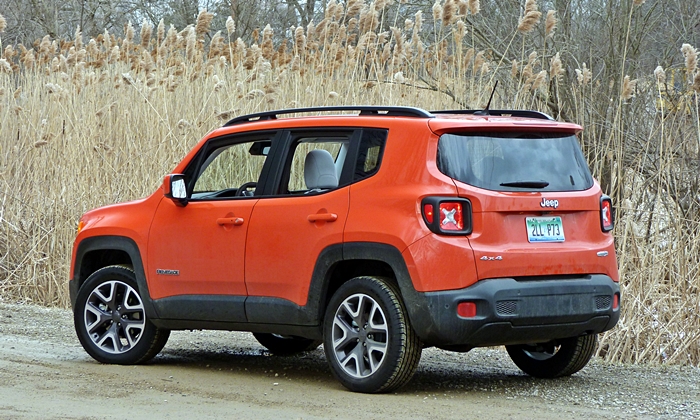
There's a lot of Jeep in the tail lamps.
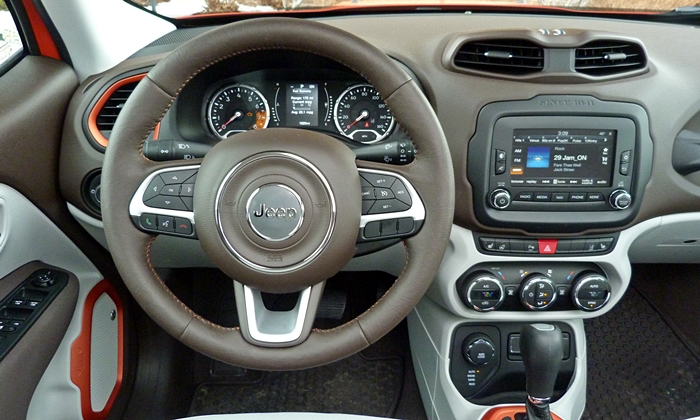
Mostly well-designed controls. But the touchscreen should be higher, as in the Fiat 500X.
| Interior styling |
 Better
Worse
Better
Worse
|
Jeep has done an even better job with the Renegade's interior styling. The interior, chock full of clever details, as a whole has an appearance and amibiance very appropriate for a Jeep. Most materials are a cut or two above the norm in a class where soft-touch instrument panels and cloth door trim aren't common. These materials are also far, far better than those in the original Compass and Patriot, which continued to seem cheap inside even after a dramatic upgrade back in 2011.
This said, I'm not entirely enthusiastic about the color combination within the tested vehicle. I really like the dark brown instrument panel and upper doors, especially with the contrast provided by plentiful bits of exterior-matching orange trim. But the seats are covered in a light gray cloth (with "Jeep" in the pattern) that not only looks like it would stain easily but doesn't really work with the brown and orange. Why combine earth tones with light gray? This is especially puzzling since sand-colored fabric is also offered, but only in combination with a black instrument panel. Why not offer a brown and sand interior instead of brown and light gray?
| Feature availability |
 Better
Worse
Better
Worse
|
More features are available on the Jeep Renegade than on any other vehicle in the class. Beyond the Trailhawk's special off-road bits, you can get a unique two-panel sunroof, a heated steering wheel, and a full array of safety tech.
More on that sunroof. With the basic version two panels (one over each row) can be removed and stored in a fitted bag in the cargo area. Initially the process proved a bit tricky, but with practice it should not be too much of a bother. Another $375 adds a conventional power sunroof mechanism to the front panel. Though good in theory, the panel retracts above the roof, generating far more wind noise than a stowed panel. Even if the front panel is removed (and even more if it is retracted) you'll want to crack a rear window to avoid uncomfortably loud reverberations inside the Renegade at speeds over 40 mph.
| |
Compared to the Trax |
| Fuel economy |
 Better
Worse
Better
Worse
|
Given the Jeep Renegade's far-from-aero shape and relatively large, 2.4-liter engine, it should come as little surprise that, even with a nine-speed automatic transmission, its EPA ratings of 21 mpg city, 29 mpg highway are significantly lower than those for most competitors. The Cherokee, though 600 pounds heavier, earns the same ratings with the same power train.
Opt for a turbocharged 1.4-liter engine and the six-speed manual it is paired with, and the Renegade's ratings improve to 24/31 (with either front-wheel drive or all-wheel drive). The 2.4 with front-wheel drive manages 22/31.
In comparison, when fitted with an automatic transmission and all-wheel drive the Chevrolet Trax achieves 24/31, the HR-V 27/32. and the Subaru Crosstrek 26/34.
In my real-world suburban driving the Renegade's trip computer reported averages ranging from 19 to 25 mpg, and usually towards the lower end of this range. The Trax's trip computer on the same roads (but with warmer temps) reported averages between 30 and 40, and most often around 36-37. The Trax did not have all-wheel drive, but this shouldn't explain more than two-to-three mpg. The HR-V and CX-3, tested with all-wheel drive, tended to average about 35 and 33, respectively. The Renegade isn't in the same league.
Some much larger SUVs have been better.
| Reliability & durability |
 Better
Worse
Better
Worse
|
The Jeep Renegade is essentially a Fiat underneath, and Fiats haven't been earning good marks in our quarterly car reliability survey. The ZF nine-speed automatic transmission used in the Renegade is also used in various Chrysler and Acura models, and many owners of those cars haven't been happy with it. On top of this, it hasn't yet been a year since the Renegade launched. So it should not come as a surprise that the limited amount of reliability data we have so far for the Renegade suggests worse-than-average (but not awful) reliability. While this doesn't constitute a red flag, a yellow flag is warranted. Buyers who expect virtually no repairs during the first few years of ownership, as some do, should probably await more solid reliability stats for the Renegade or buy something else.
The Honda HR-V similarly seems to be suffering from some first-year niggles. We don't have reliability data for the Chevrolet Trax, but the modest amount we have for the closely related Buick Encore suggests that it has been very reliable. The Subaru Crosstrek has an excellent reliability record in our survey.
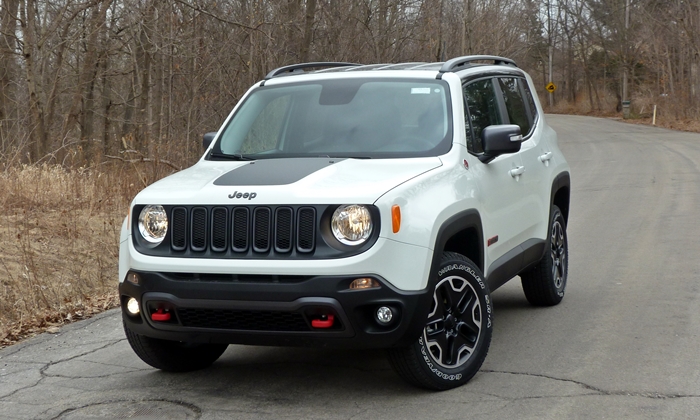
Trailhawk rides nearly an inch higher and has a black decal on the hood.
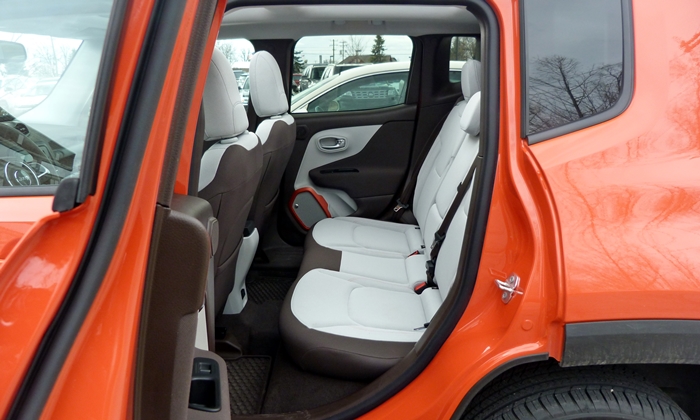
Rear seat room is about average. Tall people up front would reduce legroom further.
| |
Compared to the Trax |
| Powertrain performance |
 Better
Worse
Better
Worse
|
With a 180-horsepower engine and a nine-speed transmission, the Jeep Renegade should outscoot every competitor with the exception of the Nissan Juke (which is its polar opposite in most respects, and so unlikely to be cross-shopped anyway). In reality, the somewhat buzzy engine must be revved to at least 4,000 rpm to yield even somewhat brisk acceleration. A torquier engine (like the diesel offered in Europe) would be a better fit. Then again, brisk acceleration isn't an option with the Trax, as it is only offered with a 138-horsepower turbocharged 1.4-liter engine.
The transmission generally behaved itself during my time with the Renegade, but it's less responsive than the average current automatic. It can lug the engine, which vibrates overly much at idle. The traction control system doesn't help. Sometimes when you most need acceleration (because you're turning onto a busy road) the transmission or traction control system can cut the engine's power for a scary moment.
| Handling |
 Better
Worse
Better
Worse
|
I like how the Jeep Renegade handles given its positioning. Compared to competitors, it feels rugged. Take corners at speed, and the chassis remains predictable, composed, and fairly well balanced. (The Trailhawk, with its raised suspension, feels somewhat less athletic in on-road driving.) The steering, with a pleasant heft to it, can even provide some feedback in hard cornering. On-center and in low-g turns it feels numb, if not to the same extent as the Chevrolet's.
But agile, agile the Renegade is not. Not that it resists turning the way the Cherokee does. The Renegade enjoys changing direction, and does so confidently. But it always feels much larger than other small crossovers. Tuning contributes, but isn't the whole story. Though the Renegade is about the same length as other small crossovers, it is a substantial four inches wider than the norm. It's even an inch wider than the Cherokee. And width has more of an effect than length on how large a vehicle feels when behind the wheel. Likely due to its width, the Renegade is also heavier than other small crossovers, tipping the scales at 3,348 lbs. with all-wheel drive. (A Honda HR-V weighs over 250 pounds less.)
So, if you want a small crossover that handles like a compact hatch, this isn't the one. The related Fiat 500X could be, though even it is less fun on a twisty road than the Mini Countryman, Nissan JUKE, or Mazda CX-3. But if you want a small crossover that feels like a Jeep while still handling well, you'll be quite satisfied. Even though Jeeps aren't normally my cup of tea, I thoroughly enjoyed my week with the Renegade.
| Driving position & visibility |
 Better
Worse
Better
Worse
|
Most of the Renegade's controls are well-designed and easy to operate. But the infotainment display is on the small side and is located too low on the instrument panel for easy viewing, increasing the risk of distraction. Also, the audio system must be kept on to keep the display (which includes the clock and nav) on. You can mute it, but the resulting two-button operation to turn on the nav without turning on the audio is one more than most cars require.
The view through the distant, upright windshield could be an acquired taste. Personally, I felt that this view contributed to the Renegade's distinctively Jeep character and was sufficiently open. Large mirrors aid visibility in the other direction.
The driver seat feels somewhat mushy, at least when upholstered in cloth, but never felt uncomfortable. Unlike in other small crossovers, the lumbar bulge can be adjusted up and down as well as in and out.
| Rear seat room & comfort |
 Better
Worse
Better
Worse
|
The Jeep Renegade's width makes for more shoulder room than in the typical small crossover (if somehow still less than in the Honda HR-V), but does nothing for rear legroom. As in the Trax, I can sit behind myself with a couple inches of knee room to spare, but I'm only 5-9. Adults might not fit comfortably behind a taller driver. The class's sportiest members, including the Fiat, have even tighter rear seats, but that in the Honda is significantly roomier. You'll also find far more rear legroom in the Cherokee.
Cargo volume compares similarly. The floor can be set at one of two heights, the higher one even with the folded seats and leaving enough space beneath it for the roof panel storage bag. As in the Trax, the front passenger seat can fold forward to extend the cargo area all the way to the instrument panel.
| Price or payments |
 Better
Worse
Better
Worse
|
As mentioned in the introduction, strong brands can charge premium prices. Though a mid-level Latitude with cloth upholstery, the tested Renegade listed for $33,055. Not a small price for a small crossover. But it did have nearly every option other than the leather of the Limited or the off-road equipment of the Trailhawk. As mentioned earlier, many of the features on the tested vehicle aren't even available on most competitors.
To give one example, when the Renegade Limited is optioned to match the content of the segment's value leader, the Honda HR-V, in EX-L trim, it ends up with a list price a whopping $4,405 higher ($31,125 vs. $26.720). But $2,900 of this difference can be attributed to features on the Jeep that you cannot get on the Honda.
Go lighter on the options to more-or-less match the standard features on the top trim level of the Trax, and the Renegade Latitude lists for $1,320 more ($28,945) before adjusting for feature differences and about $800 more afterwards.
But a Renegade Limited with the same options plus leather upholstery and upgraded instruments lists for only $160 more, and if you adjust for its additional features actually undercuts the Trax by a couple hundred dollars. Unless you don't like leather, it makes more financial sense to get a Limited than a loaded-up Latitude. Why? Ask Jeep.
The Renegade lists for as little as $18,990, but that's for a front-wheel-drive, manual-transmission Sport without air conditioning, a rearview camera, alloy wheels, or a spare tire--all of which are standard on the Trax LS. Add these features plus an automatic transmission and AWD to the Renegade Sport, and its sticker jumps to $25,350, $2,655 more than that of the Trax LS AWD despite still having about $300 less content.
How can this be, when well equipped models weren't nearly so far apart? Jeep has priced its trim levels so that each step up is actually a better value once you adjust for its additional features, while Chevrolet has done the opposite.
That $25,350 Renegade Sport is also $1,105 more than a Subaru Crosstrek 2.0i Premium. Unlike the Trax, the Subaru Crosstrek is offered with the latest safety tech, and not only on its top trim level. With Subaru's "Eyesight" package, the Crosstrek 2.0i Premium lists for $26,240, over $3,000 less than a Renegade Latitude with its safety tech package, heated seats, and a temporary spare tire (the last two are standard on the Subaru). Two-thirds of the difference is due to additional content on the Jeep, some of it because the safety tech package requires other options. Compare the Limited trims of both models, and the difference is once again about $1,000 in the Subaru's favor, but without a significant adjustment for feature differences. Note that Subaru's pricing strategy parallels Jeep's: the higher trim level is a better value.
If all else were equal, the Crosstrek would seem a better value than the Renegade. But the Subaru's form factor is quite different than that of other small crossovers. Compared to the Jeep, it's nearly nine inches longer (175.2 vs. 166.6) but four inches narrower (70.1 vs. 74.2) and three inches lower (63.6 vs. 66.5). This is because the Crosstrek is really a hatchback with a suspension lift. Someone who prefers the appearance, form factor, or brand of the Jeep won't have a difficult time justifying the additional $1,000.
The Jeep Renegade isn't a perfect vehicle, but it's far more viable as a Jeep than I personally expected a small Fiat-based crossover to be. It both looks and acts the part, with a rugged feel and class-leading off-road capability, and without any significant sacrifices in on-road handling, ride quality, or utility. (Fuel economy is a different story.)
That the Renegade looks and acts a part, any part, counts for more than a little. So few affordable vehicles today have a strong, distinctive, appealing character. Compared to the Renegade, a Chevrolet Trax is painfully bland, and a Honda HR-V isn't much better. There's no question which I enjoyed spending a week with more.
For anyone concerned with off-road capability, the Renegade has only one serious challenger, the Subaru Crosstrek. The Crosstrek can't quite match the Renegade's off-road capability, but is less expensive, more fuel efficient, and (very likely) more reliable. But is it nearly as much fun? I haven't driven a Crosstrek yet. Stay tuned.
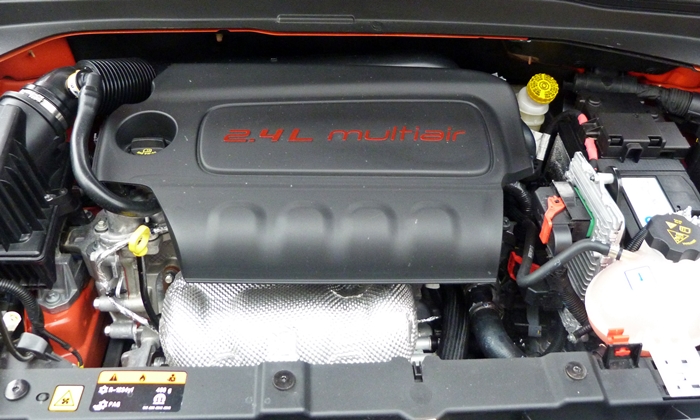
The 180-horsepower 2.4-liter engine delivers acceptable performance but subpar fuel economy.
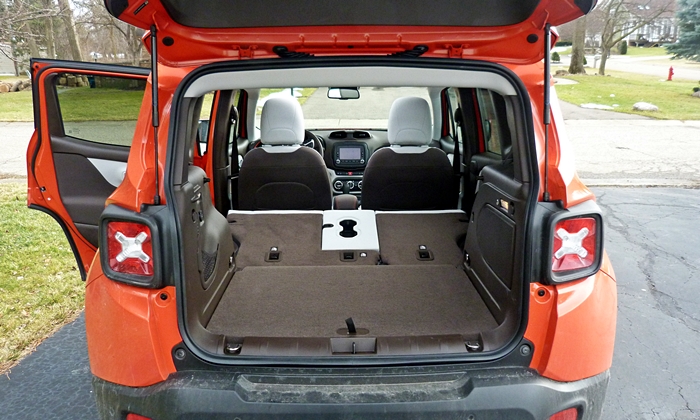
Cargo volume is about average for the class. The related Fiat 500X can't hold as much.
See more 2016 Jeep Renegade photos
Jeep and Chevrolet each provided an insured vehicle for a week with a tank of fuel. Last year Michael Williams of Southfield (MI) Jeep helpfully provided a 2015 Renegade Trailhawk. He can be reached at 248-354-2950.











